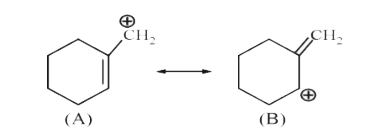Which of the following ion is colourless?
Mn2+
Cu+
Cr3+
Fe2+
The correct Answer is:B
To determine which of the given ions is colorless, we need to analyze the electronic configurations of each ion and check for the presence of unpaired electrons. Here's a step-by-step solution:
Step 1: Understand the Concept of Color in Ions
Ions are colored if they have unpaired electrons in their d-orbitals. The presence of unpaired electrons allows for d-d transitions, which absorb certain wavelengths of light and impart color to the ion. Conversely, if all electrons are paired, the ion will be colorless as d-d transitions cannot occur.
Step 2: Analyze Each Ion
We will analyze the electronic configuration of each ion provided in the question.
Ion 1: Mn²⁺
- Electronic Configuration: The electronic configuration of Mn is (Ar) 3d⁵ 4s². For Mn²⁺, two electrons are removed from the 4s orbital and one from the 3d orbital.
- Resulting Configuration: Mn²⁺ = (Ar) 3d⁵
- Unpaired Electrons: There are 5 unpaired electrons in the 3d orbitals.
- Conclusion: Mn²⁺ is colored.
Ion 2: Cu⁺
- Electronic Configuration: The electronic configuration of Cu is (Ar) 3d¹⁰ 4s¹. For Cu⁺, one electron is removed from the 4s orbital.
- Resulting Configuration: Cu⁺ = (Ar) 3d¹⁰
- Unpaired Electrons: There are no unpaired electrons (all 10 electrons in 3d are paired).
- Conclusion: Cu⁺ is colorless.
Ion 3: Cr³⁺
- Electronic Configuration: The electronic configuration of Cr is (Ar) 3d⁵ 4s². For Cr³⁺, three electrons are removed (two from 4s and one from 3d).
- Resulting Configuration: Cr³⁺ = (Ar) 3d³
- Unpaired Electrons: There are 3 unpaired electrons in the 3d orbitals.
- Conclusion: Cr³⁺ is colored.
Ion 4: Fe²⁺
- Electronic Configuration: The electronic configuration of Fe is (Ar) 3d⁶ 4s². For Fe²⁺, two electrons are removed (both from 4s).
- Resulting Configuration: Fe²⁺ = (Ar) 3d⁶
- Unpaired Electrons: There are 4 unpaired electrons in the 3d orbitals.
- Conclusion: Fe²⁺ is colored.
Step 3: Identify the Colorless Ion
From the analysis:
- Mn²⁺: Colored (5 unpaired electrons)
- Cu⁺: Colorless (0 unpaired electrons)
- Cr³⁺: Colored (3 unpaired electrons)
- Fe²⁺: Colored (4 unpaired electrons)
Final Answer
The ion that is colorless is Cu⁺.
---
Ions are colored if they have unpaired electrons in their d-orbitals. The presence of unpaired electrons allows for d-d transitions, which absorb certain wavelengths of light and impart color to the ion. Conversely, if all electrons are paired, the ion will be colorless as d-d transitions cannot occur.
We will analyze the electronic configuration of each ion provided in the question.
- Electronic Configuration: The electronic configuration of Mn is (Ar) 3d⁵ 4s². For Mn²⁺, two electrons are removed from the 4s orbital and one from the 3d orbital.
- Resulting Configuration: Mn²⁺ = (Ar) 3d⁵
- Unpaired Electrons: There are 5 unpaired electrons in the 3d orbitals.
- Conclusion: Mn²⁺ is colored.
- Electronic Configuration: The electronic configuration of Cu is (Ar) 3d¹⁰ 4s¹. For Cu⁺, one electron is removed from the 4s orbital.
- Resulting Configuration: Cu⁺ = (Ar) 3d¹⁰
- Unpaired Electrons: There are no unpaired electrons (all 10 electrons in 3d are paired).
- Conclusion: Cu⁺ is colorless.
- Electronic Configuration: The electronic configuration of Cr is (Ar) 3d⁵ 4s². For Cr³⁺, three electrons are removed (two from 4s and one from 3d).
- Resulting Configuration: Cr³⁺ = (Ar) 3d³
- Unpaired Electrons: There are 3 unpaired electrons in the 3d orbitals.
- Conclusion: Cr³⁺ is colored.
- Electronic Configuration: The electronic configuration of Fe is (Ar) 3d⁶ 4s². For Fe²⁺, two electrons are removed (both from 4s).
- Resulting Configuration: Fe²⁺ = (Ar) 3d⁶
- Unpaired Electrons: There are 4 unpaired electrons in the 3d orbitals.
- Conclusion: Fe²⁺ is colored.
From the analysis:
- Mn²⁺: Colored (5 unpaired electrons)
- Cu⁺: Colorless (0 unpaired electrons)
- Cr³⁺: Colored (3 unpaired electrons)
- Fe²⁺: Colored (4 unpaired electrons)
The ion that is colorless is Cu⁺.
Topper's Solved these Questions
- D & F-BLOCK ELEMENTS & THEIR IMPORTANT COMPOUNDS Book:RESONANCE ENGLISHChapter:D & F-BLOCK ELEMENTS & THEIR IMPORTANT COMPOUNDS Exercise:High Level Problems
Explore 2 Videos
- D & F-BLOCK ELEMENTS & THEIR IMPORTANT COMPOUNDS Book:RESONANCE ENGLISHChapter:D & F-BLOCK ELEMENTS & THEIR IMPORTANT COMPOUNDS Exercise:Subjective Questions
Explore 10 Videos
- D & F-BLOCK ELEMENTS & THEIR IMPORTANT COMPOUNDS Book:RESONANCE ENGLISHChapter:D & F-BLOCK ELEMENTS & THEIR IMPORTANT COMPOUNDS Exercise:Additional Problems for Self practice (APSP)
Explore 30 Videos
- CHEMICAL EQUILIBRIUMBook:RESONANCE ENGLISHChapter:CHEMICAL EQUILIBRIUMExercise:Advanced Level Problems (Part-3)(Stage-5)
Explore 2 Videos
- GASEOUS STATEBook:RESONANCE ENGLISHChapter:GASEOUS STATEExercise:ORGANIC CHEMISTRY(Hydrocarbon)
Explore 18 Videos
Similar Questions
Knowledge Check
Which one of the following ions is coloured ?
ASc3+BTi4+CZn2+DV2+
Which of the following are colourless?
View SolutionWhich of the following compounds is colourless and odourless?
View SolutionWhich of the following should be colourless in aqueous medium?
View SolutionWhich of the following ions is largest in size?
View SolutionWhich of the following ions is smallest in size ?
View SolutionWhich of the following ions is more stable ?

View SolutionWhich of the following ion is the largest in size ?
View Solution